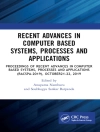Network Modeling and Simulation is a practical guide to
using modeling and simulation to solve real-life problems. The
authors give a comprehensive exposition of the core concepts in
modeling and simulation, and then systematically address the many
practical considerations faced by developers in modeling complex
large-scale systems. The authors provide examples from computer and
telecommunication networks and use these to illustrate the process
of mapping generic simulation concepts to domain-specific problems
in different industries and disciplines.
Key features:
* Provides the tools and strategies needed to build simulation
models from the ground up rather than providing solutions to
specific problems.
* Includes a new simulation tool, CASi NO built by the
authors.
* Examines the core concepts of systems simulation and
modeling.
* Presents code examples to illustrate the implementation process
of commonly encountered simulation tasks.
Offers examples of industry-standard modeling methodology that
can be applied in steps to tackle any modeling problem in
practice.
Innehållsförteckning
Preface.
Acknowledgements.
1 Basic Concepts and Techniques.
1.1 Why Is Simulation Important?
1.2 What Is a Model?
1.3 Performance Evaluation Techniques.
1.4 Development of Systems Simulation.
1.5 Summary.
Recommended Reading.
2 Designing and Implementing a Discrete-Event Simulation Framework.
2.1 The Scheduler.
2.2 The Simulation Entities.
2.3 The Events.
2.4 Tutorial 1: Hello World.
2.5 Tutorial 2: Two-Node Hello Protocol.
2.6 Tutorial 3: Two-Node Hello through a Link.
2.7 Tutorial 4: Two-Node Hello through a Lossy Link.
2.8 Summary.
Recommended Reading.
3 Honeypot Communities: A Case Study with the Discrete-Event Simulation Framework.
3.1 Background.
3.2 System Architecture.
3.3 Simulation Modeling.
3.4 Simulation Execution.
3.5 Output Analysis.
3.6 Summary.
Recommended Reading.
4 Monte Carlo Simulation.
4.1 Characteristics of Monte Carlo Simulations.
4.2 The Monte Carlo Algorithm.
4.3 Merits and Drawbacks.
4.4 Monte Carlo Simulation for the Electric Car Charging Station.
4.5 Summary.
Recommended Reading.
5 Network Modeling.
5.1 Simulation of Networks.
5.2 The Network Modeling and Simulation Process.
5.3 Developing Models.
5.4 Network Simulation Packages.
5.5 OPNET: A Network Simulation Package.
5.6 Summary.
Recommended Reading.
6 Designing and Implementing CASi NO: A Network Simulation Framework.
6.1 Overview.
6.2 Conduits.
6.3 Visitors.
6.4 The Conduit Repository.
6.5 Behaviors and Actors.
6.6 Tutorial 1: Terminals.
6.7 Tutorial 2: States.
6.8 Tutorial 3: Making Visitors.
6.9 Tutorial 4: Muxes.
6.10 Tutorial 5: Factories.
6.11 Summary.
Recommended Reading.
7 Statistical Distributions and Random Number Generation.
7.1 Introduction to Statistical Distributions.
7.2 Discrete Distributions.
7.3 Continuous Distributions.
7.4 Augmenting CASi NO with Random Variate Generators.
7.5 Random Number Generation.
7.6 Frequency and Correlation Tests.
7.7 Random Variate Generation.
7.8 Summary.
Recommended Reading.
8 Network Simulation Elements: A Case Study Using CASi NO.
8.1 Making a Poisson Source of Packets.
8.2 Making a Protocol for Packet Processing.
8.3 Bounding Protocol Resources.
8.4 Making a Round-Robin (De)multiplexer.
8.5 Dynamically Instantiating Protocols.
8.6 Putting It All Together.
8.7 Summary.
9 Queuing Theory.
9.1 Introduction to Stochastic Processes.
9.2 Discrete-Time Markov Chains.
9.3 Continuous-Time Markov Chains.
9.4 Basic Properties of Markov Chains.
9.5 Chapman-Kolmogorov Equation.
9.6 Birth-Death Process.
9.7 Little’s Theorem.
9.8 Delay on a Link.
9.9 Standard Queuing Notation.
9.10 The M/M/1 Queue.
9.11 The M/M/m Queue.
9.12 The M/M/1/b Queue.
9.13 The M/M/m/m Queue.
9.14 Summary.
Recommended Reading.
10 Input Modeling and Output Analysis.
10.1 Data Collection.
10.2 Identifying the Distribution.
10.3 Estimation of Parameters for Univariate Distributions.
10.4 Goodness-of-Fit Tests.
10.5 Multivariate Distributions.
10.6 Selecting Distributions without Data.
10.7 Output Analysis.
10.8 Summary.
Recommended Reading.
11 Modeling Network Traffic.
11.1 Introduction.
11.2 Network Traffic Models.
11.3 Traffic Models for Mobile Networks.
11.4 Global Optimization Techniques.
11.5 Particle Swarm Optimization.
11.6 Optimization in Mathematics.
11.7 Summary.
Recommended Reading.
Index.
Om författaren
Dr. Guizani is currently a Full Professor and the Chair of the Computer Science Department at Western Michigan University.
Mr. Qadan is the General Manager of Equinox International. He worked and served as a Senior Technical Director for OPNET Technologies (leading modelling and simulation vendor) between 2002 and 2005.












